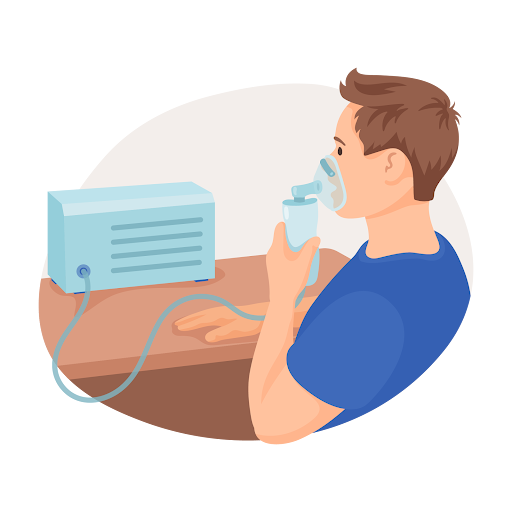Breathing Troubles: Understanding COPD Symptoms and Risk Factors

Traveling With Asthma: Tips For Using Your Inhaler And Pump On The Go
18 May 2024
If you’re one of the many individuals navigating the world with asthma, you may have found yourself puzzled about how best to handle your pump or inhaler for asthma while on the move. Does the thought of a long road trip or flying on a plane make your chest feel tight, even before you’ve left your home? It’s understandable to fret over asthma management, particularly when you’re away from your comfort zone.
Feeling carefree whilst travelling with asthma might seem like a distant dream, but armed with the right knowledge, it’s perfectly achievable. Imagine strolling by the sea without worrying about an asthma attack or exploring a new city without the fear of forgetting your inhaler in the hotel room. Sounds ideal, doesn’t it? This blog aims to fill that knowledge gap and provide practical guidance on managing your asthma whilst on the go.
Read on as we delve deeper into the best practices for travelling with asthma – from understanding how to use different types of inhalers such as Metered-Dose Inhaler (MDI), Dry Powder Inhaler (DPI), and Nebuliser, to maintenance tips for these devices during travel. Let’s make travelling a joyous experience, rather than a worrisome task, even when asthma is part of the scene
Preparation, Your Best Companion
The key to stress-free travel with asthma is preparation. Start by getting a check-up with your doctor to evaluate your current condition. Discuss your travel plans and ask for advice on managing your symptoms while you’re away from home. Knowing you’re fit for travel can set a positive tone for the journey ahead.
Ensure you have the necessary prescriptions to cover your entire trip, and possibly a bit more, just in case of any unforeseen delays. Keep all medications in their original packaging, and carry copies of your prescriptions. This can save a lot of hassle during security checks or if you need to purchase additional medication while abroad.
Metered-Dose Inhaler: Your Frequent Flyer Companion
An MDI is a handheld device that delivers a specific amount of medication in aerosol form. To use an MDI, you’ll need to breathe in slowly as you press down on the canister, holding your breath for about 10 seconds before exhaling. This ensures that the medication has time to reach your lungs and start working.
To make this easier, consider using a spacer with your MDI. The spacer holds the medicine in place so you can inhale it more comfortably and effectively. However, remember that each inhaler has its own set of instructions; always refer back to them or consult with your doctor if you’re unsure.
Dry Powder Inhalers: Dusting Off Asthma Symptoms
DPIs are another popular choice for travellers with asthma. These devices deliver medication in the form of a dry powder, which you inhale deep into your lungs. To use a DPI, you’ll need to load a dose of the medication, then inhale sharply and deeply to draw the powder into your lungs.
It’s essential not to exhale into the device before inhaling, as this can scatter the powder and make it less effective. DPIs are not typically used with spacers and require a more forceful inhalation than MDIs, so they might not be suitable for everyone.
Nebuliser for Asthma: The Heavy-duty Travel Buddy

While inhalers are more portable, sometimes you may need to rely on a nebulizer, especially during severe asthma attacks. Nebulisers transform liquid medicine into a fine mist that you can inhale through a mask or mouthpiece.
Unlike inhalers, which require a specific inhalation technique, nebulisers deliver the medication over several minutes, making them a more straightforward option for some.
Keep in mind that these devices usually require an electrical outlet and are bulkier than inhalers. Therefore, if you’re travelling with a nebuliser, make sure you have access to power sources and have packed it safely for your journey.
The Art of Asthma Pump Utilisation
Asthma pumps can be a bit tricky to handle, especially on the move. Firstly, shake the canister well before each puff. It’s important to clean the mouthpiece regularly to prevent possible infections. If you’re travelling to a place with a different climate, remember that temperature changes can affect your asthma pump’s performance.
If you’re not comfortable using your asthma pump in public places, look for quiet corners or restrooms where you can use it privately. Some people find using a spacer helpful as it slows down the medicine, making it easier to inhale.
Be Climate Smart
Climate has a huge impact on asthma. Cold, dry air can trigger an attack, as can humid, polluted environments. Arming yourself with information about the weather and pollution levels at your destination can help you prepare better. Pack appropriate clothing and consider wearing a face mask if the air quality is poor.
Keeping Calm: Your Secret Weapon
Travel can be stressful, and stress can trigger asthma attacks. At such times, it is beneficial to have an asthmarescue inhaler. Being well prepared for this trip will let you enjoy it despite having asthma. Take deep breaths when feeling anxious and keep your mind focused on the positive experiences ahead. If symptoms do flare up, know that you are well-prepared to handle them with your asthma pump and inhaler at hand.
Stepping into the world with your asthma pump or inhaler shouldn’t feel like a journey into the unknown. Embrace your travel plans with the confidence that comes from preparedness. Remember, just like how packing your trusty umbrella shields you from unexpected rains, having your inhaler or asthma pump at hand serves as a safeguard against any unforeseen asthma flare-ups. Practise using your MDI, DPI or nebuliser before you set off. This way, you can ensure that you’re well-versed in their functionality and are ready to use them even on the move.
The world is full of beauty waiting to be seen, adventures waiting to be lived and stories waiting to be told. Don’t let your asthma hold you back from being a part of it all. With the right tools such as quick-relief inhalers and the right knowledge on their usage, you can chart your own course without worry. If you’re still questioning how to plan your travel while managing asthma effectively, hop on over to tatvacare.in. We’re here with more information and resources that will support and guide you in every
FAQs
Q. Can I carry my asthma inhaler and pump in my hand luggage?
A: Absolutely, you are allowed to carry your asthma inhaler and pump in your hand baggage. However, it is advisable to carry a letter from your doctor confirming your need for these items. This could assist in case of any airport security queries.
Q. Are there any special precautions I should take while using an inhaler during flight?
A: The reduced pressure in the flight cabin might make you feel more breathless than usual. Ensure to take your medication on time and drink plenty of fluids to stay hydrated. Avoid alcohol and caffeine as it could causes dehydration, which could exacerbate asthma symptoms.
Q. What should I do if I forget my inhaler at home?
A: In case you’ve left your inhaler at home, try to remain calm. Seek medical assistance immediately from the nearest healthcare centre or pharmacy. Explain your situation clearly, as they can provide you with a temporary solution or replacement for your inhaler.
Q. How do I manage my asthma symptoms in a new climate?
A: A sudden change in climate can trigger asthma symptoms. It’s recommended to keep an eye on the weather forecast and adjust your medication schedule as advised by your doctor. Always have your inhaler handy and try to avoid extreme temperatures when possible.
Q. Is it safe to participate in adventure activities while travelling with asthma?
A: Yes, you can participate in adventure activities provided your asthma is well-controlled. However, always carry your inhaler and make sure people around you are aware of your condition.

Medically reviewed by
Dr. Devina Aswal 
MBBS, DDM, FCR, CIC
Recent Blog
- AI in Healthcare: Not a Threat, but a Smart Ally
- Your Clinic. Your Website. Your Brand.
- CDSS – Revolutionising Diagnosis with AI-Powered Clinical Decision Support System
- Handwritten to Digital in Seconds: SmartSync Converts Prescriptions Instantly
- Voice Rx by TatvaPractice: A Smarter Way to Digitise Prescriptions
Archives
Categories
- Asthma (20)
- Diabetes (15)
- Fatty Liver (20)
- High Blood Pressure (2)
- High cholesterol (2)
- Hypertension (2)
- Insulin Resistance (1)
- Obesity (8)
- PCOS (6)
- TatvaPractice (13)
Let’s Connect
Quick contact



